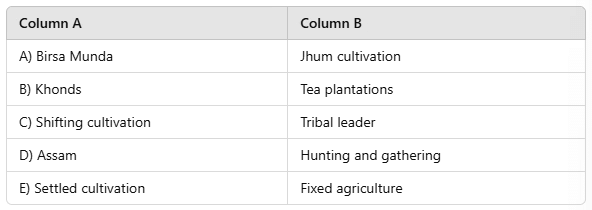Tribals, Dikus and the Vision of a Golden Age Class 8 Worksheet History Chapter 4
| Table of contents |

|
| Multiple Choice Questions (MCQs) |

|
| Fill in the Blanks |

|
| True or False |

|
| Match the Following |

|
| Very Short Answer Questions |

|
Multiple Choice Questions (MCQs)
Q1: Who was Birsa Munda?
A) A British official
B) A tribal leader
C) A landlord
D) A missionary
Q2: What type of cultivation did jhum cultivators practice?
A) Settled cultivation
B) Shifting cultivation
C) Commercial cultivation
D) Industrial agriculture
Q3: What was the primary occupation of the Khonds?
A) Farming
B) Hunting and gathering
C) Herding animals
D) Settled agriculture
Q4: Which of the following was considered a diku?
A) A tribal member
B) The British
C) A local farmer
D) A forest dweller
Q5: What did Birsa Munda aim to achieve with his movement?
A) Establish British rule
B) Restore tribal rights
C) Promote Christianity
D) Develop industrial agriculture
Fill in the Blanks
Q1: The British described the tribal people as __________.
Q2: The method of sowing seeds in jhum cultivation is known as __________.
Q3: The tribal chiefs got __________ titles in central India under the British land settlements.
Q4: Tribals went to work in the __________ of Assam and the ____________ in Bihar.
Q5: Birsa Munda's movement aimed at establishing a __________.
True or False
Q1: Jhum cultivators plough the land and sow seeds.
Q2: Cocoons were bought from the Santhals and sold by the traders at five times the purchase price.
Q3: Birsa urged his followers to purify themselves, give up drinking liquor and stop believing in witchcraft and sorcery.
Q4: The British wanted to preserve the tribal way of life.
Q5: The Baigas were known as the best hunters among all adivasis in Central India.
Match the Following

Very Short Answer Questions
Q1: Who was Birsa Munda?
Q2: What did Birsa Munda urge his followers to give up?
Q3: What was jhum cultivation?
Q4: How did British rule affect tribal chiefs?
Q5: What was the vision of a golden age?
You can find Worksheets Solutions here: Worksheet Solutions: Tribals, Dikus and the Vision of a Golden Age
|
87 videos|558 docs|53 tests
|
FAQs on Tribals, Dikus and the Vision of a Golden Age Class 8 Worksheet History Chapter 4
| 1. Who are the tribals mentioned in the article? |  |
| 2. What challenges do the tribals face from Dikus? |  |
| 3. What is the significance of the 'Golden Age' vision for the tribals? |  |
| 4. How did colonial policies impact the lives of tribals? |  |
| 5. What role did movements play in the struggle of tribals against Dikus? |  |





















